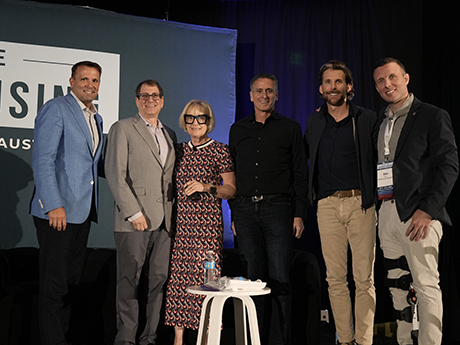By Katie Sloan
AUSTIN, TEXAS — The ‘State of the Industry’ panel at the 17th annual InterFace Student Housing conference held more of a trepidatious tone than heard in recent years. While pre-leasing levels and rental rates are still above historical norms, the industry is seeing a slight deceleration in pre-leasing speed and rate growth, leading some to question what the industry has in store for the year ahead. The discussion — held on April 10 in Austin, Texas — was moderated by Alex O’Brien, CEO with Cardinal Group.
The best way to characterize the industry this year is hesitant according to Ryan Lang, executive vice chairman with Newmark, who believes investor reluctance is largely due to pre-leasing numbers falling a couple of points behind levels seen at this time last year. Still, levels are trending far ahead of pre-leasing levels seen in 2019, lending to confidence overall in the sector.
Editor’s note: InterFace Conference Group, a division of France Media Inc., produces networking and educational conferences for commercial real estate executives. To sign up for email announcements about specific events, visit www.interfaceconferencegroup.com/subscribe.
“The past two years were unprecedented from a leasing perspective with properties leasing up the fastest and with the highest rents growths on record,” he said. “What we’re hearing from our biggest clients is that we’re going to see 5 percent to 7 percent rent growth on average this year. Pre-leasing is hovering at 70 percent, which is a couple of points behind last year as mentioned, but we think we’re trending well by historical measures and we’re seeing a lot of capital enter the space.”
A lion share of rent growth belongs to 15 to 20 markets however, according to Lang, making the current environment ‘a have and have-nots’ market. As we continue through uncertain times both geopolitically and economically, this is lending to a flight to quality markets and locations for investors, according to Ken Carl, senior managing director with Kayne Anderson Real Estate.
“We’re really focused on the Power Five markets and pedestrian-to-campus assets,” said Carl. “We’re looking at 6.5 percent rent growth right now and leasing in the high 70 percent range, so we’re almost 10 percentage points ahead of where we were last year. We’ve been fortunate in markets like Purdue University where supply and demand fundamentals have been on our side. Even in tougher markets like Gainesville, Florida, we’re seeing double-digit rent growth this year. It all speaks to the benefits of a flight to quality and having the right properties in the right locations.”
And the ‘have and have nots’ characterization can also be used for the resident mindset with relation to affordability, according to Andrew Stark, principal of Timberline Real Estate Ventures. “As an industry, we must pay attention to the headwinds in front of us and we’re seeing a ‘have or have nots’ with price points on our units right now as well,” he said. “In markets where we have both a newer, high-rise asset and an affordably priced community we’re seeing the more affordable product being leased up at a faster pace. I believe we might have gotten to the point where the elasticity of the pricing power of parents is tightening. Affordable housing is really driving leasing velocity these days and that’s a trend to watch.”
But Donna Preiss, founder and CEO of The Preiss Co, noted that the type of product that drives high pre-leasing is dependent on the market. “When we look at some of our best performing properties, we have some of our communities with the highest rent prices in markets like Chapel Hill, North Carolina, and then some of our properties with the lowest rents — like one of our very affordable communities near Clemson University and our affordable housing project near Georgia Southern University,” she said. “So we are definitely seeing a trend towards affordable housing, but the preferences of the student population really does differ from market to market.”
In keeping with this trend, several university markets that have been a boon of profitability over the past few years from a rent growth standpoint are also beginning to soften, according to Isaac Sitt, co-CEO of Vesper Holdings.
“We had a great run near the University of South Florida in Tampa over the past few years, but as the Tampa multifamily market has softened, student housing properties have been impacted,” Sitt said. “But markets like Lexington, Kentucky, and Tuscaloosa, Alabama, that do not have a big city nearby are outperforming with rent growth because they don’t have the shadow market competition of a big city.”
As we move through 2025, the shifting emphasis on unit affordability and the implications of softening shadow markets are expected to be trends to watch with relation to the types of communities developed in the sector as well as the rent growth we can expect to see over the next few years.


